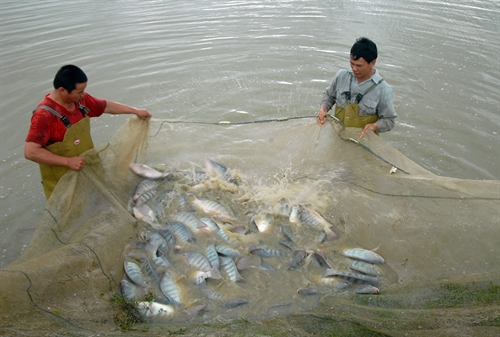 Economy
Economy

Việt Nam is striving to add tilapia to tra fish and shrimp as a key fisheries export.
 |
| Local fishermen harvest tilapia in Quảng Ninh Province. The Ministry of Agriculture and Rural Development recently approved a tilapia farming scheme through 2020. VNA/VNS Photo Quang Quyết |
HCM CITY – Việt Nam is striving to add tilapia to tra fish and shrimp as a key fisheries export.
The Ministry of Agriculture and Rural Development recently approved a tilapia farming scheme for the period until 2020 that will develop large-scale farms with diverse and high-value products for both the domestic and foreign markets, ensure supply of fries for breeding, control diseases and raise farmers’ incomes.
By 2020 the fish is expected to be farmed on an area of 33,000 hectares and 1.5 million cubic metres of cages in rivers and ponds, with annual output at 300,000 tonnes, 50-60 per cent of which will be exported.
By 2030 the area would increase to 40,000ha and 1.8 million cubic metres of cages, with the output increasing to 400,000 tonnes, 45-50 per cent of it for export.
All the produce will be of VietGap standards.
The scheme envisages farming the fish in seven geographies -- northern midland and mountainous regions, northern lowlands, north-central and south-central regions, Central Highlands, and south-eastern and south-western regions.
Not long ago international experts blamed Việt Nam for ignoring tilapia though it had geographic and climatic advantages to farm the fish.
Meanwhile, seafood exporters sought to ensure a sufficient and steady supply of the fish for processing to meet not only domestic but also large export demand, partly leading to the formulation of the programme.
Việt Nam’s tilapia exports have seen strong growth over the past decade or so, increasing from US$1.95 million in 2004 to more than $32.2 million in 2014.
It sells the fish to more than 60 countries and territories.
But the exports remain relatively low compared with the potential, according to the Directorate of Fisheries.
According to the Việt Nam Association of Seafood Producers and Exporters, the EU imports tens of thousands of tonnes each year, mainly in frozen form from Asian countries like China and Indonesia.
The US is also a major consumer of the fish.
Agro-fishery-forestry exports
The agro-fishery-forestry exports recovered by end of May 2016, after a drop last year, driven by improved demand and a number of free trade agreements (FTAs) which took effect.
According to statistics from the Ministry of Agriculture and Rural Development, the agro-fishery-forestry exports rose 4.9 per cent over the same period last year to touch a revenue of $12.18 billion. The export revenue reached $2.32 billion in May alone.
Agricultural products accounted for nearly half of the total export revenue, or $6.5 billion, rising by 6.6 per cent over the same period last year.
Fisheries exports earned a turnover of $2.43 billion, representing a rise of 1.1 per cent while forestry exports saw a fall of 1.8 per cent to $2.69 billion.
Coffee saw the largest growth in exports in the five-month period, shipping 797,000 tonnes abroad, totally worth $1.36 billion, up 34 per cent in volume and rising more than 10 per cent in value over the same period last year, despite the average coffee export price dropping by some 18 per cent.
Việt Nam’s rice exports rose 1.2 per cent to earn $1.06 billion from a shipment of 2.35 million tonnes despite Thailand’s plan to accelerate sales of 11.4 million tonnes of stockpiled rice within two months starting in May.
Nguyễn Chí Kiên, from the Institute of Policy and Strategy for Agriculture and Rural Development, said that despite the biggest planned stockpiled rice sale clearance from Thailand, rice prices have recovered in recent weeks.
Rubber and cashew also grew in the first five months of this year with revenues of $561 million and $910 million, respectively.
Wood and wooden products exports dropped by 1.8 per cent to $2.56 billion.
Việt Nam imported $8.7 billion worth of agro, fishery and forestry products in the first five months, decreasing by 7.6 per cent, and helping the sector run up a trade surplus of $3.4 billion.
Last year, the sector’s exports posted a slight drop of 0.8 per cent to $30.14 billion. – VNS




